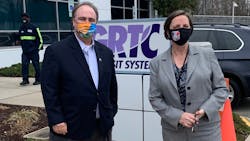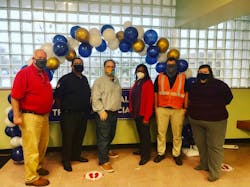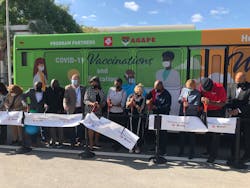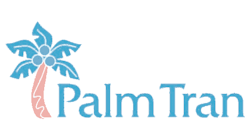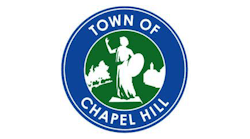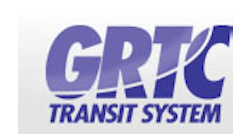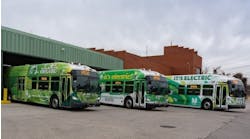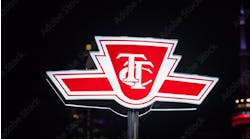A July 2020 New York Times article surveyed the state of public transportation after a few months of coronavirus shutdowns and dramatic loss of ridership and revenue across the U.S. and summarized, “This could plunge systems into a ‘transit death spiral,’ where cuts to service and delayed upgrades make public transit a less convenient option for the public, which prompts further drops in ridership, causing spiraling revenue loss and service cuts, until a network eventually collapses.”
Since then, agencies reeled from a second wave of the virus and the attendant lock downs of commuters who were required to work from home by government mandate. Then in the early part of 2021, another wave of virus spread across the land, but transit agencies began to adapt and provide new types of service that enabled their passengers to access more of life’s opportunities. I heard of this first-hand in my interviews with transit agency executives on my “Transit Unplugged” podcast and in conversations with transit and city leaders around the country.
I decided it was time to go out and see it for myself. So, in March 2021, I arranged visits with numerous transit agencies and companies down the US I-95 corridor from near Washington, D.C., to South Florida to visit in person for the first road trip I had been on in more than a year - following all safety protocols in place. I wanted to shine a spotlight on some of the great things happening in transit and share best practices along the way.
GRTC - Richmond, Virginia
The trip kicked off on March 16 in Richmond, Va., where my Trapeze colleague K.J. Reynolds and I visited with Julie Timm, CEO of Greater Richmond Transit Corporation (GRTC) and her staff. She told us we were the first non-employee visitors they have had in their facility for a year. She shared with us some of the great safety protocols they had put in place and plan to continue into the future, such as temperature checks upon entry to the facility, mandatory face masks, PPE, hand sanitizer that they locally sourced from a distillery, Plexiglas barriers and marks on the floor for social distancing.
Julie discussed their interest in potentially staying fare free for their service. She also stated that their local bus routes have recovered ridership back to almost pre-COVID-19 levels. They have put most of their resources into that service to ensure that the local essential workers continue to have access to jobs and more, stating “mobility is prosperity.”
Chapel Hill Transit - Chapel Hill, North Carolina
He also spoke about their coordination with other transit services in the Research Triangle area and how they have now begun to develop good connections with neighboring towns. They were one of the first transit systems in the nation to install ultraviolet (UV) light cleaning systems in their buses and building. They are pursuing Bus Rapid Transit and already have five corridors with high frequency transit (15-minute headways) through the town and campus. With many hybrid buses already in their fleet, now the town is looking to move toward electric battery buses and exploring solar-powered charging.
“We're trying to not only invest our service, but also starting to invest in zero-emission buses,” said Litchfield.
We presented the latest transit trends from their conference room while the staff watched on-screen from their offices.
My colleague KJ Reynolds pointed out that, “transit buses are already the most complex type of vehicle on the road, with 10 or more computers, and 30 plus components like transmissions, differentials, CNG tanks, air dryers, fire suppression systems …. each with their own maintenance tasks, delivered at intervals based on time, miles, hours or fuel consumption.” He continued, “and now, throw in the tracking and delivery of additional cleaning tasks, post COVID and probably forever, plus the electrification of many fleets and it becomes clear that the right asset management technology for bus maintenance is more important than ever.”
CARTA - Charleston, South Carolina
JTA - Jacksonville Florida
“After a difficult year for our community, the JTA is looking forward to a future full of opportunities and innovation,” said Ford. “Thank you to Paul for taking time to see the great work we’re doing in Jacksonville first-hand.”
After the podcast interview, Greer Gillis, JTA vice president of system development, took me on an extensive tour of JTA’s facility and operations. I met with senior operations staff, dispatchers and their paratransit operator MV Transportation’s general manager. We discussed trends, technology and operations improvements.
Then I got to spend the rest of the sunny Florida afternoon at the JTA Autonomous Vehicle (AV) Test and Learn Facility with some brilliant guys, Bernard Schmidt, vice president of automation and innovation and William Frazer, director of automation and quality assurance. There they showed me how they are testing many different brands of AVs and working directly with the OEMs to make improvements for potential expansion of their use in public mobility. Amazing work with a great test track. They also work with local schools and the community college to use the facility as an educational beacon to interest young people in transit technology and innovation.
Finally, I autographed copies of my book The Future of Public Transportation for the JTA Board of Directors and senior staff. Looking forward to my next visit with the amazing JTA team of visionaries who are helping transit remain relevant and even expand its mission to better serve their community.
PalmTran – Palm Beach, Florida
The next visit was with the Palm Beach, Fla., transit system, PalmTran and its CEO Clinton Forbes. They too just cut the ribbon on a new administration and operations building in Delray, Fla., and PalmTran Director of Support Services Gilbert Morales who oversaw construction gave me an in-depth tour of this yet to be occupied facility. Afterwards, Forbes was the guest for a podcast interview where he told me about Palm Tran’s COVID-19 response including interior bus cleaning (stanchions and seats) at the end of the lines so passengers can see the buses being cleaned.
Forbes said, “We’ve gotten so many great compliments by the public seeing that. It gives them real confidence in riding the system”.
They also are adding new flex routes and microtransit to better meet the needs of their community. PalmTran is part of the county government so we discussed that structure and how it helps integrate them into the overall government coordination efforts in response to the pandemic.
Palm Beach TPA – Palm Beach, Florida
A big priority for the TPA is to improve pedestrian and bicycle safety as well as implement an enhanced transit network to achieve their vision of a safe, efficient and connected multimodal transportation system.
As Neilson stated, “A Complete Streets Policy can help ensure safety and access for transportation users of all ages and abilities, including people walking, bicycling and riding transit.”
I then provided a presentation on the Future of Public Transportation that was livestreamed for attendees to participate in person and virtually. We wrapped up the presentation with Q&A followed by a book giveaway and signing for participants who attended in person.
Overview
Overall, the message of the trip is that while COVID-19 has dealt a gut punch to the public transportation industry in terms of ridership and revenue, transit agencies are resilient and adapting to meet the changing mobility needs of the public. Most transit services have implemented strict safety protocols and adjusted routes to meet demand. Others are bringing in new high tech, individualized services such as microtransit, Mobility-as-a-Service, and flex routes to improve the customer experience. Agencies are upgrading their technology to contactless payment solutions, better asset management and on-demand applications with common payment platforms to meet the needs of today’s customers.
Additionally, most are moving toward zero-emission buses to provide a green and clean fleet. Plus, many cities have moved to more pedestrian, bicycle and public mobility-friendly streetscapes by reducing auto access to streets and city centers.
Finally, new approaches to transit including free transport to get the vaccines and actually bringing the vaccine on the bus to the public are reimagining the role of public transit to focus on today’s mobility needs. Transit agencies are engaged with their community, focused on recovery and ensuring the vital links transit provides to jobs, medical care, groceries and other essential needs are met now.
------------------
Paul Comfort is senior vice president, chief customer officer at Trapeze Group, best selling author and host of the Transit Unplugged podcast.
